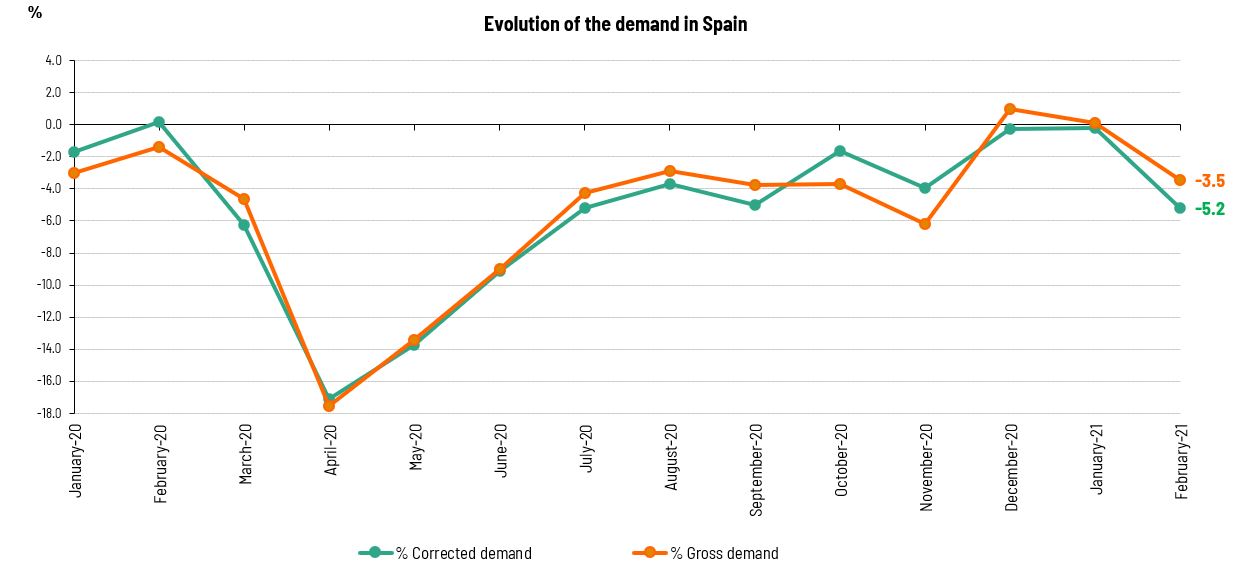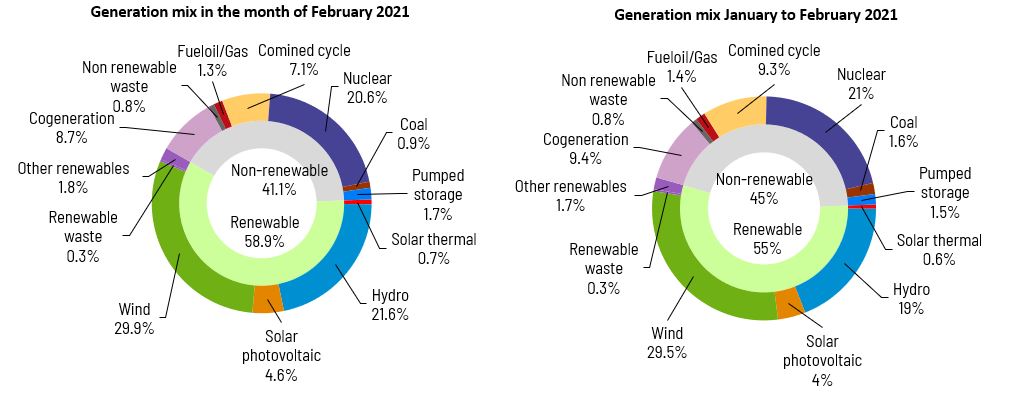We are a global operator of essential infrastructure
- Considering the fact that February 2020 had an extra day as it was a leap year, and after having factored in the influence of seasonal and working patterns, demand registered a fall of 5.2% compared to the same month last year.
- Except for 4 February, the Spanish electricity system closed every day of the month with an overall balance of renewable generation that was higher than the generation produced using polluting energy sources, which meant that 58.9% of national production for the month came from renewable energy sources.
- Electricity demand fell by 10.4% in the Balearic Islands and 17.2% in the Canary Islands compared to February 2020.
National electricity demand in February is estimated at 20,254 GWh, a value that is 3.5% lower than that registered in the same month last year. After having factored in the influence of seasonal and working patterns, the figure is 5.2% lower than in the same month last year.

In the first two months of 2021, demand is estimated at 44,114 GWh, 1.5% less than in 2020. Once again, having factored in the influence of seasonal and working patterns, demand is 2.5% lower than in 2020.
In the month of February, and according to data estimated at the time of this press release, generation coming from renewable energy sources represented 58.9% of the total production nationwide, registering a value that is 43.3% higher than in the same period in 2020. With the exception of one day, 4 February, when renewables produced 44.5% of the total, throughout the month more than half of the daily production came from renewable technologies and even reached shares of up to 68.4% of the total (on 1 and 20 February).
Furthermore, in February, 81.2% of electricity production was obtained using technologies which produce zero CO2 emissions.
With information available as at the time of this press release, wind energy generation in February reached 6,346 GWh, a figure that is 48.6% higher than in the same period last year, and represented 29.9% of production nationwide, ranking as the leading technology in the national generation mix, ahead of hydro (21.6%) and nuclear (20.6%).
.

Demand for electrical energy in the peninsular electricity system falls by 2.8%
Demand for electrical energy in the peninsular electricity system in the month of February is estimated at 19,276 GWh, a value that is 2.8% lower than that recorded in the same month last year. After having factored in the influence of seasonal and working patterns, the demand for electricity is 4.6 down on that registered in the February 2020.
In the first two months of 2021, electricity demand on the Spanish Peninsula is estimated at 41,982 GWh, a figure that is 1% less than in the same period in 2020. In this case, after having factored in the influence of seasonal and working patterns, demand is 2% lower than that recorded in the same period of the previous year.
During this month, and according to data estimated at the time of this press release, 60.9% of peninsular generation came from renewable energy sources and 84.1% was obtained using technologies which produce zero CO2 emissions. For its part, wind energy stood at 6,286 GWh, 50.5% higher than in February last year, and became the leading technology by contributing 30.9% to the overall generation mix.
Demand for electricity in February falls 10.4% in the Balearic Islands and 17.2% in the Canary Islands
In the Balearic Islands, electricity demand in February is estimated at 361,279 MWh, a value that is 10.4% lower than that recorded in February 2020, which had 29 days as it was a leap year. If this is taken into account and after factoring in the influence of seasonal and working patterns, the figure is 10.9% less than in February 2020.
In the first two months of 2021, demand in the Balearic Islands is estimated in gross terms at 832,000 MWh, 3.2% less than in the same period in 2020.
Combined cycle, with 77.2% of the total production in the Balearic Islands, was the leading source of electricity generation in February, a month in which renewable technologies and those which produce zero CO2 emissions accounted for 7.9% of the total generation mix in the Archipelago.
Furthermore, energy transferred via the Spanish Peninsula-Balearic Islands submarine link contributed to covering 31.4% of the electricity demand in the Balearic Islands.
Regarding the Canary Islands, electricity demand is estimated at 584,289 MWh, 17.2% less than that recorded in February last year. If we take into account that 2020 was a leap year and after factoring in the influence of seasonal and working patterns, the figure stands at a value that is 17.4% lower than in the same month last year.
In the first two months of 2021, demand in the Canary Islands is estimated in gross terms at 1,231,483 MWh, 15.8% less than in the same period last year.
In February, combined cycle was also the leading technology in the Canary Islands’ generation mix with a contribution of 47.9%. Renewable technologies and those which produce zero CO2 emissions represented 13.6% of the total generation on the Canary Islands.
Consult our Daily Balance Report for more information on the National, Peninsular, Balearic Islands and Canary Islands electricity systems as at the close of February.














